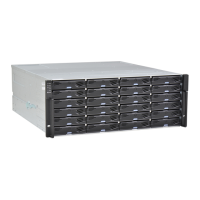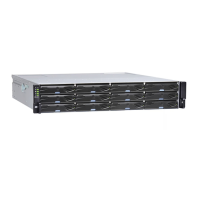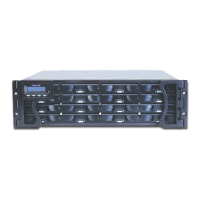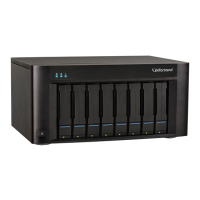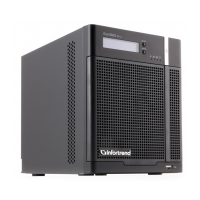2-17EonStor DS 3000 Series Hardware Manual
• When connecting between devices, follow all the specications. Pay attention to the signals and
avoid electronic noise from adjacent interfaces. DO NOT put power cords on optical cables.
• Route the cables away from places where it can be damaged by other devices such as fan exhaust
or foot trafc.
• DO NOT overtighten, twist, or bend the cables.
Conguring the host-side topologies
When conguring host-side topologies, avoid the points of failure. It is recommended that the host ports
are connected to at least two HBAs.
NOTES:
• To manage the fault-tolerant data paths and optimize data throughput on multiple data paths, you
must apply MPIO software or other multipathing utilities such as Linux Device Mapper.
• Host port channel designation may vary by system. Refer to the topologies of this manual to create
your own connections that suit your needs.
Conguring the host-side parameters
For the host-side parameters, we strongly recommend that you use the default settings of your system.
If you need to adjust the host-side parameters, consult your on-site technical personnel or seek
technical support from your vendor.
Familiarizing the Maximum Concurrent Host LUN Connection (Nexus in SCSI)
The menu option Max Number of Concurrent Host-LUN Connection allows you to set the maximum
number of concurrent host LUN connections. This is the arrangement of the controller internal resources
to use with a number of current host nexus.
For example, if you have four hosts (A, B, C, and D) and four host IDs/LUNs (IDs 0, 1, 2, and 3) in a
conguration, where:
• Host A accesses ID 0 (one nexus)
• Host B accesses ID 1 (one nexus)
• Host C accesses ID 2 (one nexus)
• Host D accesses ID 3 (one nexus)
These connections are queued in the cache, which are called four nexus. If there is an I/O in the cache
with these four nexus and another host I/O comes with a nexus different from the four in the cache (e.g.
host A accesses ID 3), the controller returns as busy. This happens with the concurrent active nexus. If
the cache is cleared, it accepts four different nexus again. Many I/O operations can be accessed via the
same nexus.
Knowing Maximum Queued I/O Count
The menu option Maximum Queued I/O Count allows you to congure the maximum number of I/O
operations per host channel that can be accepted from the servers. The predened range is from
1 to 1024 I/O operations per host channel. You can also choose Auto, which sets the automatic
conguration. The default value is 256 I/O operations. The appropriate setting for this option depends
on how many I/O operations the attached servers are performing. This varies according to the amount
of the host memory present as well as the number of drives and their respective sizes. Usually, the
optimum performance occurs from using Auto or 256 settings. For more information, refer to the
rmware manual that came with your system.

